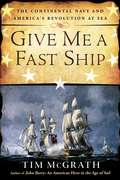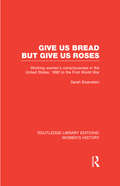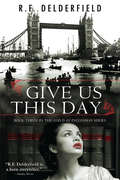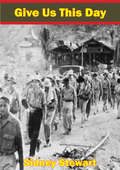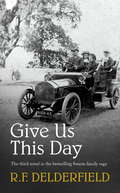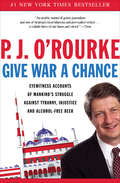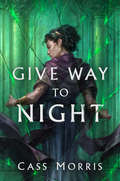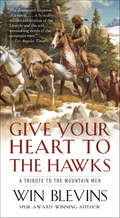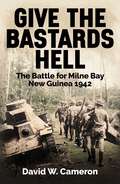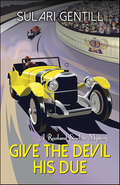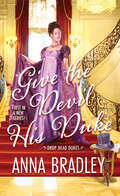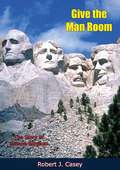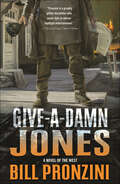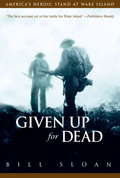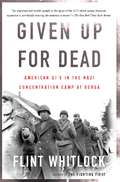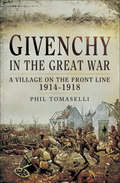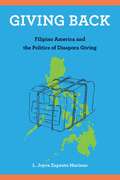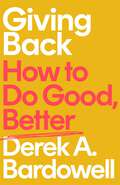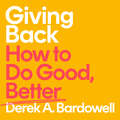- Table View
- List View
Give Me a Fast Ship
by Tim McgrathFive ships against hundreds--the fledgling American Navy versus the greatest naval force the world had ever seen... America in 1775 was on the verge of revolution--or, more likely, disastrous defeat. After the bloodshed at Lexington and Concord, England's King George sent hundreds of ships westward to bottle up American harbors and prey on American shipping. Colonists had no force to defend their coastline and waterways until John Adams of Massachusetts proposed a bold solution: The Continental Congress should raise a navy. The idea was mad. The Royal Navy was the mightiest floating arsenal in history, with a seemingly endless supply of vessels. More than a hundred of these were massive "ships of the line," bristling with up to a hundred high-powered cannon that could level a city. The British were confident that His Majesty's warships would quickly bring the rebellious colonials to their knees. They were wrong. Beginning with five converted merchantmen, America's sailors became formidable warriors, matching their wits, skills, and courage against the best of the British fleet. Victories off American shores gave the patriots hope--victories led by captains such as John Barry, the fiery Irish-born giant; fearless Nicholas Biddle, who stared down an armed mutineer; and James Nicholson, the underachiever who finally redeemed himself with an inspiring display of coolness and bravery. Meanwhile, along the British coastline, daring raids by handsome, cocksure John Paul Jones and the "Dunkirk Pirate," Gustavus Conyngham--who was captured and sentenced to hang but tunneled under his cell and escaped to fight again--sent fear throughout England. The adventures of these men and others on both sides of the struggle rival anything from Horatio Hornblower or Lucky Jack Aubrey. In the end, these rebel sailors, from the quarterdeck to the forecastle, contributed greatly to American independence. Meticulously researched and masterfully told, Give Me a Fast Ship is a rousing, epic tale of war on the high seas--and the definitive history of the American Navy during the Revolutionary War. INCLUDES ILLUSTRATIONS
Give Me a Fast Ship: The Continental Navy and America's Revolution at Sea
by Tim McgrathFive ships against hundreds—the fledgling American Navy versus the greatest naval force the world had ever seen… America in 1775 was on the verge of revolution—or, more likely, disastrous defeat. After the bloodshed at Lexington and Concord, England’s King George sent hundreds of ships westward to bottle up American harbors and prey on American shipping. Colonists had no force to defend their coastline and waterways until John Adams of Massachusetts proposed a bold solution: The Continental Congress should raise a navy. The idea was mad. The Royal Navy was the mightiest floating arsenal in history, with a seemingly endless supply of vessels. More than a hundred of these were massive “ships of the line,” bristling with up to a hundred high-powered cannon that could level a city. The British were confident that His Majesty’s warships would quickly bring the rebellious colonials to their knees. They were wrong. Beginning with five converted merchantmen, America’s sailors became formidable warriors, matching their wits, skills, and courage against the best of the British fleet. Victories off American shores gave the patriots hope—victories led by captains such as John Barry, the fiery Irish-born giant; fearless Nicholas Biddle, who stared down an armed mutineer; and James Nicholson, the underachiever who finally redeemed himself with an inspiring display of coolness and bravery. Meanwhile, along the British coastline, daring raids by handsome, cocksure John Paul Jones and the “Dunkirk Pirate,” Gustavus Conyngham—who was captured and sentenced to hang but tunneled under his cell and escaped to fight again—sent fear throughout England. The adventures of these men and others on both sides of the struggle rival anything from Horatio Hornblower or Lucky Jack Aubrey. In the end, these rebel sailors, from the quarterdeck to the forecastle, contributed greatly to American independence. Meticulously researched and masterfully told, Give Me a Fast Ship is a rousing, epic tale of war on the high seas—and the definitive history of the American Navy during the Revolutionary War.INCLUDES NINE MAPS AND SIXTEEN PAGES OF FULL COLOR ILLUSTRATIONS
Give Us Bread but Give Us Roses: Working Women's Consciousness in the United States, 1890 to the First World War (Routledge Library Editions: Women's History)
by Sarah EisensteinRooted in the printed sources of the period, this book reconstructs the attitudes of a pioneer generation of young women to the conflicts brought about by their new experience of employment outside their homes, and to changes in work and family relationships. In the 1890s and after the still prevalent Victorian conception of respectable womanhood excluded wage-earning women. Yet working-class women themselves did not acquiesce in this judgement, and Eisenstein’s exploration of Victorian ideas about women and work – using the contemporary middle-class literature of advice and prescription to this new workforce – makes a historical study which is a classic of its kind. The book was originally published in 1983.
Give Us This Day
by R. Delderfieldin the beloved classic God Is an Englishman saga "A heroic finale to the author's cavalcade of middle-class life." -W. B. Hill, Best Sellers Sweeping Adam Swann and three generations of his family into the tide of events that followed Queen Victoria's Diamond Jubilee in 1897, this stirring novel confronts them, and England, with the social upheaval of a rapidly changing world. The same revolutionary ferment that stirs up labor unrest also births the English suffragette movement, taking the family idealist, Giles, to Parliament. With conflicting interests, two of his brothers usher the family's firm into the twentieth century and another Swann brother, Alex, a professional soldier, attempts to introduce an outmoded army to modern tactics. Like their aging father, these Swanns strive energetically to wed personal dreams to national values-even as the rumble of the guns of August 1914 signals the end of the world as they and their country have known it. Give Us This Day is a stirring saga of England in the late nineteenth and early twentieth century, as the social upheaval begins and the Great War looms, forever changing the landscape of England and her people. "Mr. Delderfield's vast public will find here...his undimmed facility as a storyteller." -The New Yorker "Rich and rewarding, the sort of thing to read at leisure and peacefully. Moreover, it is authentic...It has the spirit of the times." -Library Journal
Give Us This Day (Swann Family Saga #3)
by R. F. DelderfieldSweeping Adam Swann and three generations of his family into the tide of events that followed Queen Victoria's Diamond Jubilee in 1897, this stirring novel confronts them, and England, with the social upheaval of a rapidly changing world. The same revolutionary ferment that stirs up labor unrest also births the English suffragette movement, taking the family idealist, Giles, to Parliament. With conflicting interests, two of his brothers usher the family's firm into the twentieth century and another Swann brother, Alex, a professional soldier, attempts to introduce an outmoded army to modern tactics. Like their aging father, these Swanns strive energetically to wed personal dreams to national values-even as the rumble of the guns of August 1914 signals the end of the world as they and their country have known it. Give Us This Day is a stirring saga of England in the late nineteenth and early twentieth century, as the social upheaval begins and the Great War looms, forever changing the landscape of England and her people.
Give Us This Day [Illustrated Edition]
by Sidney StewartIncludes The Prisoners Of War In Japanese Hands During World War Two pack with 130 photos, plans and photos.In Give Us This Day a young Oklahoman, a survivor of Bataan, reveals the terrible truth about a little-known aspect of the Pacific war as he experienced it from the beginning in the Philippines. He was a captive of the Japanese for more than three years; he knew one after another all the torments of confinement in conditions of primitive barbarism. True though his story is, it almost defies belief. With touching simplicity he recounts the stark and shocking details of one of the most shameful features of that war -- the treatment of American soldiers who fell into the hands of the Japanese. At first Stewart hated his captors, but in the end hatred gave place to a dawning comprehension that the Japanese were as different from us as the men of Genghis Khan."It is one of the most harrowing and debilitating chronicles that I have read. . . . He describes the ordeal brilliantly; he harbors no resentments apparently, and he has emerged from an inferno of bestiality with utter serenity." -- Maxwell Geismar, Saturday Review"An impressive and moving book." -- David Dempsey, New York Times"His is no ordinary prisoner-of-war story; better written than most, it contains no tales of swashbuckling defiance. . . . The force of this book is its testimony to the indomitable strength of the human spirit." -- Manchester Guardian"The plain narrative of this story would by itself have been fascinating, but this book is far more than a story, it is a work of art." -- André Siegfried, Academie Francaise"Sidney Stewart's composed narrative is one of the most noble documents ever penned by a prisoner of war. The companions he writes about remained men to the end, until at last only one man remained; he survived to write this unforgettable, this magnificent story." -- George Slocombe, New York Herald Tribune [Paris]
Give Us This Day: From one of the best-loved authors of the 20th century
by R. F. DelderfieldAdam Swann has grown old, and is struggling to keep up with the changing times. The Victorian age is giving way to the Edwardian and the horse is being overtaken by the motorcar, with devastating effect on his transport business. As the new century is born, the Boer war brings tragedy, but even this cannot quench the indomitable spirit of the Swann family.
Give Us This Day: From one of the best-loved authors of the 20th century
by R. F. DelderfieldAdam Swann has grown old, and is struggling to keep up with the changing times. The Victorian age is giving way to the Edwardian and the horse is being overtaken by the motorcar, with devastating effect on his transport business. As the new century is born, the Boer war brings tragedy, but even this cannot quench the indomitable spirit of the Swann family.
Give War a Chance: Eyewitness Accounts of Mankind's Struggle Against Tyranny, Injustice, and Alcohol-Free Beer
by P. J. O'RourkeIn the spirit of his savagely funny and national best-seller Parliament of Whores, Give War a Chance is P. J. O'Rourke's number one New York Times bestselling follow-up. O'Rourke runs hilariously amok by tackling the death of Communism, sanctimonious liberals, and America's perennial bad guy Saddam Hussein in a series of classic dispatches from his coverage of the 1991 Gulf War. Here is our most mordant and unnervingly funny political satirist on: Kuwait City after the Gulf War: "It looked like all the worst rock bands in the world had stayed there at the same time." On Saddam Hussein, O'Rourke muses: "He's got chemical weapons filled with ... chemicals. Maybe he's got The Bomb. And missiles that can reach Riyadh, Tel Aviv, Spokane. Stock up on nonperishable foodstuffs. Grab those Diet Coke cans you were supposed to take to the recycling center and fill them up with home heating oil. Bury the Hummel figurines in the yard. We're all going to die. Details at eleven."
Give Way to Night (Aven Cycle #2)
by Cass MorrisThe second book of the Aven Cycle explores a magical Rome-inspired empire, where senators, generals, and elemental mages vie for power.Latona of the Vitelliae, mage of Spirit and Fire, is eager to wield her newfound empowerment on behalf of the citizens of Aven--but societal forces conspire to keep her from exercising her gifts, even when the resurgence of a banished cult plots the city's ruin. To combat this threat, Latona must ally with Fracture mage Vibia, the distrustful sister of Sempronius Tarren.While Latona struggles to defend their home, Sempronius leads soldiers through wartorn provinces to lift the siege of Toletum, where Latona's brother Gaius is hemmed in by supernatural forces. Sempronius must contend not only with the war-king Ekialde and his sorcerers, but with the machinations of political rivals and the temptations of his own soul, ever-susceptible to the darker side of ambition.Though separated by many miles soon after their love affair began, Latona and Sempronius are united by passion as they strive to protect Aven and build its glorious future.
Give Your Heart to the Hawks: A Tribute to the Mountain Men
by Win BlevinsStunningly portrayed by Leonardo DiCaprio in the Golden Globe Award-winning and twelve-time Academy Award nominated film The Revenant. Mountain man Hugh Glass’s harrowing journey 300 miles to civilization after being mauled by a grizzly bear and left for dead is just one of the incredible adventures Spur Award Winning author Win Blevins explores in the New York Times bestseller, Give Your Heart to the Hawks. In addition to the captivating story of Hugh Glass, Win Blevins presents a poetic tribute to these dauntless "first Westerners" who explored the Great American West from the time of Lewis and Clark into the 1840s. As trappers in a hostile, trackless land, their exploits opened the gates of the mountains for the wagon trains of pioneers who followed them. Here, among many, are the enthralling stories of: * John Colter, who, in 1808, naked and without weapons or food, escaped captivity by the Blackfeet and ran and walked 250 miles to Fort Lisa at the mouth of the Yellowstone River; * Kit Carson, who ran away from home at age 17, became a legendary mountain man in his 20s and served as scout and guide for John C. Fremont's westward explorations of the 1840s; * Jedediah Smith, a tall, gaunt, Bible-reading New Yorker whose trapping expeditions ranged from the Rockies to California and who was killed by Comanches on the Cimarron in 1831.At the Publisher's request, this title is being sold without Digital Rights Management Software (DRM) applied.
Give a Man a Fish: Reflections on the New Politics of Distribution
by James FergusonIn Give a Man a Fish James Ferguson examines the rise of social welfare programs in southern Africa, in which states make cash payments to their low income citizens. More than thirty percent of South Africa's population receive such payments, even as pundits elsewhere proclaim the neoliberal death of the welfare state. These programs' successes at reducing poverty under conditions of mass unemployment, Ferguson argues, provide an opportunity for rethinking contemporary capitalism and for developing new forms of political mobilization. Interested in an emerging "politics of distribution," Ferguson shows how new demands for direct income payments (including so-called "basic income") require us to reexamine the relation between production and distribution, and to ask new questions about markets, livelihoods, labor, and the future of progressive politics.
Give the Bastards Hell: The Battle for Milne Bay, New Guinea 1942
by David W. CameronIn New Guinea&’s jungles, a fierce battle turned the tide of the Pacific War—the first major land defeat for the unstoppable Japanese forces. By mid-August 1942, Imperial Japanese forces dominated the Southeast Asian and Pacific theatres, seemingly unstoppable in their advance. While the Japanese South Seas Force pushed north toward Port Moresby along the Kokoda Track, they launched an operation against Milne Bay at the eastern tip of New Guinea. Their objective: to seize the crucial Allied airfields under construction, which would pave the way for capturing Port Moresby and consolidating their hold on the region. For two intense weeks, Japanese marines, supported by tanks and naval bombardments, battled through the jungle-covered strip of land between the beaches and mountains. Facing them was a determined and diverse Allied force—Australian militia, 2nd AIF troops, American engineers, and, critically, Australian fighter pilots—who fought the Japanese to a standstill near the partially completed Air Strip No. 3. Despite desperate human wave attacks by the Japanese, the Allies held their ground. When the smoke cleared, the Japanese had suffered their first significant land defeat since Pearl Harbor. The Battle of Milne Bay marked a turning point in the Pacific War, signalling the beginning of the end for the Imperial Japanese Empire.
Give the Devil His Due (Rowland Sinclair WWII Mysteries #7)
by Sulari GentillA fascinating historical mystery by Sulari Gentill, author of #1 LibraryReads pick The Woman in the LibraryWinner of the 2018 Ned Kelly Award for Best MysteryFor fans of Rhys Bowen, Kerry Greenwood and Jacqueline Winspear comes an adventure-packed romp that threads 1934 Sydney's upper class and its seedy underworld.Wealthy Rowland Sinclair, an artist with leftist friends and a free-wheeling lifestyle, reluctantly agrees to a charity race. He'll drive his beloved yellow Mercedes on the Maroubra Speedway, renamed the Killer Track for the lives it has claimed. His teammates are a young Errol Flynn and the well-known driver Joan Richmond. It's all good fun. But then people start to die...The body of a journalist covering the race is found murdered in a House of Horrors. An English blueblood with Blackshirt affiliations dies in a Maroubra crash. Reporters stalk Rowly for dirt while bookmakers are after an edge. When someone takes a shot at him—it could be anyone. Then the police arrest one of Rowly's housemates for murder.For fans of Golden Age mysteries—but with a bohemian twist—this historical novel features a riveting crime, a wry, almost British sense of humor, and an amateur sleuth you can't help but root for. Other Rowland Sinclair Mysteries: A Few Right Thinking MenA Decline in ProphetsMiles off CoursePaving the New RoadA Murder UnmentionedGentlemen Formerly Dressed
Give the Devil His Duke (Drop Dead Dukes #1)
by Anna BradleySet against the Bridgerton-era backdrop of Regency London, Anna Bradley&’s witty and sexy new trilogy sets fiercely alpha dukes against the duchesses who are determined to transform their delinquent husbands by any means necessary. A delight for fans of Mary Jo Putney, Sabrina Jeffries, Ella Quinn, Diana Quincy and Julia Quinn. One should never judge a duke by his cover. As far as London society knows, Giles Drew, the Duke of Basingstoke, is everything a proper aristocrat ought to be. But when a notorious scandal sheet publishes details of Giles&’s questionable bedroom antics, only one bride can salvage his reputation. Prim and penniless, Francesca Stanhope has resigned herself to a season full of the ton&’s snickering—until the Duke of Basingstoke&’s dizzying courtship transforms her fate. Yet wedded bliss quickly turns into a clash of wills as Franny realizes her handsome duke is a devil in disguise. But beneath the newlywed&’s skirmishes lies scorching heat. And while each attempts to tame the other, the truth is that this unconventional union may be all either could ever desire . . .
Give the Man Room: The Story of Gutzon Borglum
by Mary Borglum Robert CaseyTHE SCULPTOR WHO CARVED THE FACES OF AMERICA’S HEROIC DEAD ON GRANITE MOUNTAINS—AND THEY WERE SELDOM BIG ENOUGH.First published in 1952, Robert John Casey co-wrote this fascinating biography with the wife of Gutzon Borglum (1867-1941), the American sculptor best known for his colossal sculpture of the faces of four U.S. presidents on Mount Rushmore in South Dakota. The son of Danish immigrants, Gutzon Borglum studied art in San Francisco and for four years in Paris at the Académie Julian and the École des Beaux-Arts. His painting and his sculpture were admitted to the officially recognized Salon and he subsequently received important commissions and royal recognition whilst in England. In 1901 Borglum established himself in New York City, where he sculpted a bronze group called The Mares of Diomedes, the first piece of American sculpture bought for the Metropolitan Museum of Art in New York. Versatile and prolific, Borglum sculpted many portrait busts of American leaders, as well as of figures such as the Twelve Apostles, which he created for the Cathedral Church of St. John the Divine in New York. He turned toward reviving the ancient Egyptian practice of carving gargantuan statues of political figures in natural formations of rock, and executed from a six-ton block of marble a colossal head of President Abraham Lincoln, which was placed in the Capitol Rotunda in Washington, D.C. This led to a commission in 1927 by the state of South Dakota to turn Mount Rushmore, in the Black Hills, into another colossal monument, and that same year Borglum began sculpting the 60-foot-high heads of George Washington, Thomas Jefferson, Abraham Lincoln, and Theodore Roosevelt on the face of the mountain. The project was completed in 1941 and became a national memorial.Physically only medium-sized, Borglum was a big man, colorful, worth knowing. The change to know him is here in the stimulating pages of Give the Man Room.
Give-a-Damn Jones: A Novel of the West
by Bill PronziniMystery Writers of America Grand Master Bill Pronzini debuts a thrilling western with expert storytelling and a mysterious hero who will appeal to Pronzini's Nameless fans.Not all the folks who roamed the Old West were cowhands, rustlers, or cardsharps. And they certainly weren’t all heroes.Give-a-Damn Jones, a free-spirited itinerant typographer, hates his nickname almost as much as the rumors spread about him. He’s a kind soul who keeps finding himself in the wrong place at the wrong time.That’s what happened in Box Elder, a small Montana town. Tensions are running high, and anything (or anyone) could be the fuse to ignite them: a recently released convict trying to prove his innocence, a prominent cattleman who craves respect at any cost, a wily traveling dentist at odds with a violent local blacksmith, or a firebrand of an editor who is determined to unlock the town’s secrets.Jones walks into the middle of it all, and this time, he may be the hero that this town needs.At the Publisher's request, this title is being sold without Digital Rights Management Software (DRM) applied.
Given Up for Dead: America's Heroic Stand at Wake Island
by Bill SloanA gripping narrative of unprecedented valor and personal courage, here is the story of the first American battle of World War II: the battle for Wake Island. Based on firsthand accounts from long-lost survivors who have emerged to tell about it, this stirring tale of the "Alamo of the Pacific" will reverberate for generations to come. On December 8, 1941, just five hours after the bombing of Pearl Harbor, Japanese planes attacked a remote U. S. outpost in the westernmost reaches of the Pacific. It was the beginning of an incredible sixteen-day fight for Wake Island, a tiny but strategically valuable dot in the ocean. Unprepared for the stunning assault, the small battalion was dangerously outnumbered and outgunned. But they compensated with a surplus of bravery and perseverance, waging an extraordinary battle against all odds. When it was over, a few hundred American Marines, sailors, and soldiers, along with a small army of heroic civilian laborers, had repulsed enemy forces several thousand strong--but it was still not enough. Among the Marines was twenty-year-old PFC Wiley Sloman. By Christmas Day, he lay semiconscious in the sand, struck by enemy fire. Another day would pass before he was found--stripped of his rifle and his uniform. Shocked to realize he hadn't awakened to victory, Sloman wondered: Had he been given up for dead--and had the Marines simply given up? In this riveting account, veteran journalist Bill Sloan re-creates this history-making battle, the crushing surrender, and the stories of the uncommonly gutsy men who fought it. From the civilians who served as gunmen, medics, and even preachers, to the daily grind of life on an isolated island--literally at the ends of the earth--to the agony of POW camps, here we meet our heroes and confront the enemy face-to-face, bayonet to bayonet.
Given Up for Dead: American GI's in the Nazi Concentration Camp at Bergda
by Flint WhitlockDuring World War II, prisoners of war were required by the Geneva Conventions to be treated according to established rules. But in late 1944, when a large number of Americans were captured or surrendered during the Battle of the Bulge and elsewhere, their captors had different plans. Those who were Jewish or from some other "undesirable" ethnic or religious group were separated from their fellow captives and sent to the brutal slave-labor camp at Berga. Until now, the story of what these men endured has been a well-guarded secret.
Givenchy in the Great War: A Village on the Front Line, 1914–1918
by Phil TomaselliThe village of Givenchy-ls-la-Basse sits on a small rise in the Pas de Calais Department in northern France. One hundred years ago it was overtaken by the First World War. The fighting there was intense eleven Victoria Crosses were won in this tiny locality between 1914 and 1918. Phil Tomasellis in-depth account shows what happened at Givenchy when it became a battlefield, and the story here was repeated in the other villages and towns on the Western Front. Givenchys key position made it the target for crushing bombardments, infantry assaults and subterranean warfare. The landscape was pulverized by shellfire, the ground beneath was honeycombed with tunnels. Mining operations, shelling, sniping and trench raids took place around the remains of the village even when this stretch of the front line was relatively quiet. The grueling struggle of attrition that characterized the fighting on the Western Front continued here throughout the war. Phil Tomasellis gripping narrative makes extensive use of war diary extracts, personal stories, official and unofficial histories.
Giving A Damn: Racism, Romance And Gone With The Wind
by Patricia Williams‘I cannot help but see the bodies of my near ancestors in the current caravans of desperate souls fleeing from place to place, chased by famine, war and toxins. Ideas honed in slavery – of the otherness, the boorishness, the inferiority of thy neighbour – have continued to travel through American society.’ The story of slavery in America is not over. It lives on in how we speak to one another, in how we treat one another, in how our societies are organised. In Giving a Damn, the legal scholar Patricia Williams finds that when you begin to unpick current debates around immigration, freedom of speech, the culture wars and wall-building, beneath them lies the unexamined history of enslavement in the West. Our ability to dehumanize one another can be traced all the way from the plantation to the US President’s Twitter account.
Giving Back: Filipino America and the Politics of Diaspora Giving (Asian American History & Cultu #222)
by L. Joyce MarianoMany Filipino Americans feel obligated to give charitably to their families, their communities, or social development projects and organizations back home. Their contributions provide relief to poor or vulnerable Filipinos, and address the forces that maintain poverty, vulnerability, and exploitative relationships in the Philippines. This philanthropy is a result of both economic globalization and the migration of Filipino professionals to the United States. But it is also central to the moral economies of Filipino migration, immigration, and diasporic return. Giving-related practices and concerns—and the bonds maintained through giving—infuse what it means to be Filipino in America. Giving Back shows how integral this system is for understanding Filipino diaspora formation. Joyce Mariano “follows the money” to investigate the cultural, social, economic, and political conditions of diaspora giving. She takes an interdisciplinary approach to reveal how power operates through this charity and the ways the global economic and cultural dimensions of this practice reinforce racial subordination and neocolonialism. Giving Back explores how this charity can stabilize overlapping systems of inequality as well as the contradictions of corporate social responsibility programs in diaspora.
Giving Back: Filipino America and the Politics of Diaspora Giving (Asian American History & Cultu #222)
by L. Joyce MarianoMany Filipino Americans feel obligated to give charitably to their families, their communities, or social development projects and organizations back home. Their contributions provide relief to poor or vulnerable Filipinos, and address the forces that maintain poverty, vulnerability, and exploitative relationships in the Philippines. This philanthropy is a result of both economic globalization and the migration of Filipino professionals to the United States. But it is also central to the moral economies of Filipino migration, immigration, and diasporic return. Giving-related practices and concerns—and the bonds maintained through giving—infuse what it means to be Filipino in America. Giving Back shows how integral this system is for understanding Filipino diaspora formation. Joyce Mariano “follows the money” to investigate the cultural, social, economic, and political conditions of diaspora giving. She takes an interdisciplinary approach to reveal how power operates through this charity and the ways the global economic and cultural dimensions of this practice reinforce racial subordination and neocolonialism. Giving Back explores how this charity can stabilize overlapping systems of inequality as well as the contradictions of corporate social responsibility programs in diaspora.
Giving Back: How to Do Good, Better
by Derek A. BardowellDo you wish you could do more to change the world but don't know how? Do you ever look around at the many charities asking for donations and feel overwhelmed? This inspiring and uplifting book explores the effectiveness of charity and calls for more radical giving if we want to contribute to a better world. During a period when British society seems more divided than ever, and our decision makers are even more disconnected from the issues that keep us awake at night, Giving Back highlights the people and movements taking on some of the most challenging social issues of our time.A respected figure in philanthropy, Derek A. Bardowell presents a unique insight into what's going on inside the world of giving and where we can best make a difference.From redefining the role of charity itself to reimagining philanthropy through a reparative lens, Bardowell introduces a radical new take on how social problems, from climate change to racial injustice, can be tackled in modern society by all of us.Filled with lively insights and moving stories, Giving Back is here to break down the walls of charitable giving. If you loved Factfulness, Lost Connections, and What White People Can Do Next, this book will challenge some of your truths and change the way you give.What people are saying about Derek A. Bardowell:'Personal, political, powerful.' Bernardine Evaristo'Important and timely... Deeply felt and illuminating... Essential reading for everyone committed to fairness and equality in life.' Goodreads Reviewer, 5 stars'A valuable act of remembrance... While wealth may confer privileges, it doesn't rid you of melanin or exempt you from prejudice.' Colin Grant, Guardian'Bardowell does an excellent and passionate job of refracting the issues.' Financial Times'I absolutely loved it!... Such a good read on so many levels.' Goodreads Reviewer, 5 stars
Giving Back: How to Do Good, Better
by Derek A. BardowellDo you wish you could do more to change the world but don't know how? Do you ever look around at the many charities asking for donations and feel overwhelmed? This inspiring and uplifting book explores the effectiveness of charity and calls for more radical giving if we want to contribute to a better world. During a period when British society seems more divided than ever, and our decision makers are even more disconnected from the issues that keep us awake at night, Giving Back highlights the people and movements taking on some of the most challenging social issues of our time.A respected figure in philanthropy, Derek A. Bardowell presents a unique insight into what's going on inside the world of giving and where we can best make a difference.From redefining the role of charity itself to reimagining philanthropy through a reparative lens, Bardowell introduces a radical new take on how social problems, from climate change to racial injustice, can be tackled in modern society by all of us.Filled with lively insights and moving stories, Giving Back is here to break down the walls of charitable giving. If you loved Factfulness, Lost Connections, and What White People Can Do Next, this book will challenge some of your truths and change the way you give.What people are saying about Derek A. Bardowell:'Personal, political, powerful.' Bernardine Evaristo'Important and timely... Deeply felt and illuminating... Essential reading for everyone committed to fairness and equality in life.' Goodreads Reviewer, 5 stars'A valuable act of remembrance... While wealth may confer privileges, it doesn't rid you of melanin or exempt you from prejudice.' Colin Grant, Guardian'Bardowell does an excellent and passionate job of refracting the issues.' Financial Times'I absolutely loved it!... Such a good read on so many levels.' Goodreads Reviewer, 5 stars
